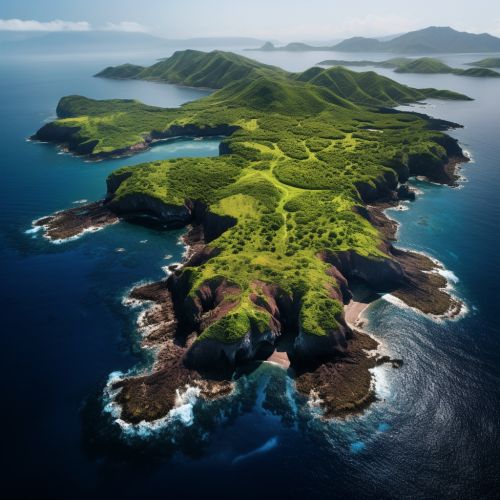Hawaii hotspot
Introduction
The Hawaii hotspot is a volcanic hotspot located in the northern Pacific Ocean, near the namesake U.S. state of Hawaii. The hotspot is responsible for the creation of the Hawaiian – Emperor seamount chain, a chain of volcanoes over 5,800 kilometers long. Four of these volcanoes are active, two are dormant, and more than 123 are extinct, having been eroded beneath the ocean's surface.
Geology
The Hawaii hotspot is an example of a hotspot in geology. Hotspots are regions of the earth's mantle where plumes of hot magma rise to the earth's surface. The magma from the hotspot has created a series of volcanic islands and seamounts over millions of years. The movement of the Pacific Plate over the stationary hotspot has resulted in a chain of islands and seamounts stretching from the Big Island of Hawaii to the Aleutian Trench in the north Pacific.


Formation and Evolution
The Hawaii hotspot has been active for at least 70 million years, producing a volcanic chain that extends 3,600 miles (5,800 km) across the Pacific Ocean. The hotspot's activity is thought to have begun with the creation of the Emperor Seamounts, a chain of underwater mountains in the Pacific Ocean. As the Pacific Plate moved northwest over the hotspot, new volcanoes were formed and the older volcanoes moved away from the hotspot, becoming extinct and eroding into seamounts.
Current Activity
The Hawaii hotspot is currently producing active volcanoes on the Big Island of Hawaii. The most active volcano is Kilauea, which has been erupting continuously since 1983. The other active volcano is Mauna Loa, which last erupted in 1984. The other two active volcanoes, Hualalai and Mauna Kea, are currently dormant.
Impact on Hawaii
The Hawaii hotspot has had a profound impact on the Hawaiian Islands. The volcanic activity has created the islands themselves, and the rich volcanic soil supports a diverse range of flora and fauna. The hotspot has also created a unique cultural and spiritual significance for the native Hawaiian people, who believe the volcanoes to be the home of the goddess Pele.
Future Predictions
Geologists predict that the Hawaii hotspot will continue to produce new islands in the future. The next island, named Loihi, is already forming underwater to the southeast of the Big Island. It is predicted to emerge above the ocean's surface in the next 10,000 to 100,000 years.
